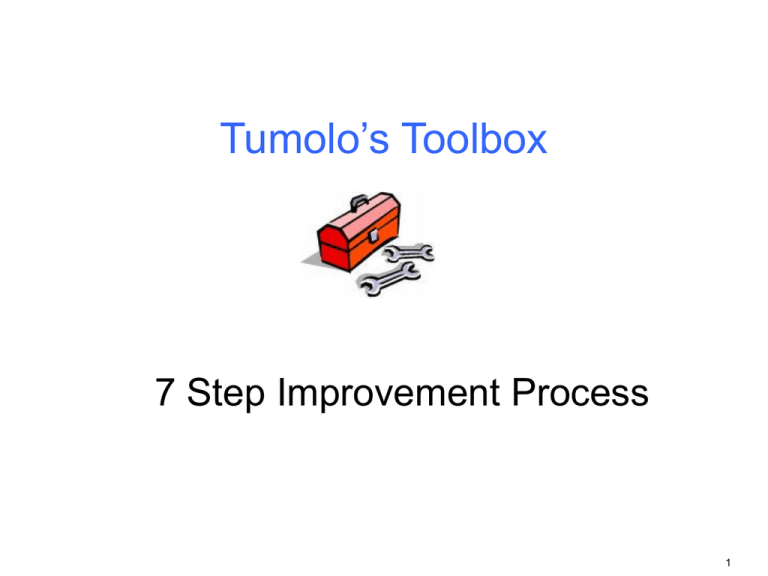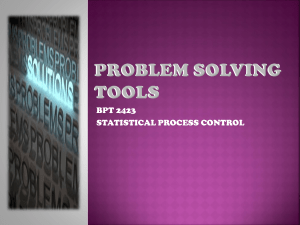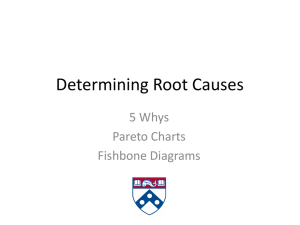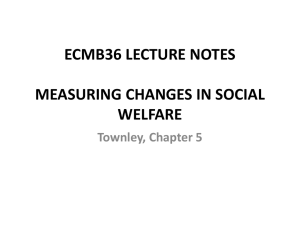7 Step process
advertisement

Tumolo’s Toolbox 7 Step Improvement Process 1 Elements of process improvement and control Every process has three (3) elements 1. The area of discovery Understanding the customer requirements and developing the process to meet these requirements 2. The method of process control Assessing performance and variation 3. The element of improvement Problem solving and quality improvement 2 Process Improvement Opportunity or Problem Identification 7 Step Improvement Process Process Control 3 the in innovation insight invention inspiration intuition instinct prayer clairvoyance Copy Imitation consultation Benchmark Other world Inner self Improvement or Problem gut feel others real world systematic PDCA 7 Steps random trial-and-error guess accident chance luck delegation negotiation just waiting passing-the-buck confusing finger pointing transferring 4 PDCA 7 STEP 1. Select a Theme PLAN 2. Collect Data 3. Analyze causes/opportunities DO 4. Plan and implement 7 QC Tools Check sheet, graph, Histogram, scatter diagram, Pareto diagram, cause-and-effect diagram, flowcharts Flowcharts solution / improvement CHECK 5. Evaluate effects ACT Check sheet, graph, Histogram, scatter diagram, Pareto diagram, cause-and-effect diagram, run chart/control chart Flowchart 6. Standardize 7. Reflect on process (provides repetition) (provides process) (provides tools) 5 7 Step improvement process 1. Select Theme 2. Collect Data 3. Analyze Causes 4. Plan Solution and Implement 5. Evaluate 6. Standardize • Focus on weakness • Thoroughly explore the problem/opportunity • Carefully select the theme • Clearly state the theme • Have weakness orientation • State as a problem/gaps, not a solution • State in terms of results 7. Reflect on Process 6 Selecting the theme • Weakness is difference between current situation and the target. • Weakness orientation focuses on eliminating weakness as basis of improvement (Closing the Gap). Current } Weakness Target Customer Need } Weakness Actual Performance Focus on facts, processes, and root causes 7 7 Step improvement process 1. Select Theme 2. Collect Data 3. Analyze Causes 4. Plan Solution and Implement 5. Evaluate 6. Standardize 7. Reflect on Process • Define your data collection process • Appropriate to process • Multi-variable data • Analyze the data • Stratification • Graphics • Focus on deviation • Draw a logical conclusion • Based on facts • Focus on vital few “Primary tool used is Pareto Diagram 8 Frequently used data collection tools CHECKSHEET PARETO DIAGRAM CONTROL CHART GRAPH (RUN CHART) HISTOGRAM Used to systematically collect data or tabulate data. (e.g. frequency of occurrence of defect types) Excellent method to identify vital few. (2 levels minimum) (e.g. Percent of failures due to various defect types arranged in descending order of occurrence) Method to identify non-standard process variation (e.g. Solder paste height versus time) Method to identify trends in data (e.g. In circuit test yield versus time) Method to identify distribution of the data (e.g. Number or solder paste observations falling into various height ranges) 9 7 Step improvement process 1. Select Theme • Create cause-and-effect diagram from Pareto 2. Collect Data • Investigate cause thoroughly 3. Analyze Causes • Draw logical conclusions (i.e. supported by data) 4. Plan Solution and Implement 5. Evaluate 6. Standardize 7. Reflect on Process Ask Why?5 times 10 100% 4th why Methods 2nd why Material 5th why Pareto Diagram 3rd why 1st why A Man Machine Cause effect Diagram A B C D E F • ASK 5 WHYS to get to the proper level of analysis and causes. • Segment by 4 Ms • Man • Machine • Methods • Material 11 Verifying Root Causes Collect data on root causes Use run charts, Pareto, Graphs, scattergrams, etc. to determine strength of correlation between root cause and problem If verification fails to validate choices, return to diagram and choose new root causes to verify. 12 7 Step improvement process 1. Select Theme • Focus on the primary root causes 2. Collect Data • Focus on solution which you can implement 3. Analyze Causes • Dont try to fix everything at once 4. Plan Solution and Implement • Involve those who will be affected 5. Evaluate • Run a controlled experiment (Pilot) 6. Standardize 7. Reflect on Process 13 Total Score Feasibility A tool to help determine which solution is best. Effectiveness Solectron Criteria Solution 1 Solution 2 Solution 3 Solution 4 ------Scoring values Possible score values = HIGH 3 or 6 = MEDIUM 2 or 3 = LOW 1 14 A tool to help determine ease or difficulty in solving specific problems. Area of Problem Data Collection/ Potential solution implementation You You and Others Others Equipment Methods Human Behavior Easy Easy Difficult Moderately Difficult Difficult Moderately Difficult Very Difficult Difficult Very Difficult 15 Solution Implementation What When Where Who How How will they get it done Who is responsible for doing it Where will it be done When will it be done What will be done 16 7 Step improvement process 1. Select Theme • Confirm improvement (Before and after comparison) 2. Collect Data • Evaluate all subsequent effects 3. Analyze Causes • Measure improvement gains over time 4. Plan Solution and Implement 5. Evaluate 6. Standardize 7. Reflect on Process 17 Original Pareto “BEFORE 100% New Pareto “AFTER Pareto Diagram Pareto Diagram A B C D E F A B C D 100% } } Improvement Effect on Root Cause “Fewer defects E F 18 7 Step improvement process 1. Select Theme 2. Collect Data 3. Analyze Causes • Move from PDCA to SDCA cycle • Revise the standard • Create a process to detect future problems 4. Plan Solution and Implement 5. Evaluate 6. Standardize 7. Reflect on Process 19 Standardization PDCA SDCA New Std Plan Do Act Check Std Act Do Check Control Improvement 20 7 Step improvement process • Analyze strengths and weaknesses 1. Select Theme 2. Collect Data • Determine the next problem • Document the Quality improvement story 3. Analyze Causes 4. Plan Solution and Implement • Identify the critical difficulties during the process - using tools, etc. 5. Evaluate • Identify the critical strengths 6. Standardize • Identify the key things the team would do differently 7. Reflect on Process • Identify what key things the team needs to learn to improve the 7 step process. 21











